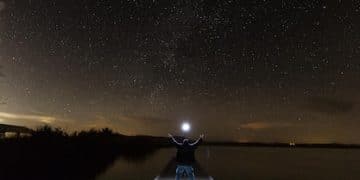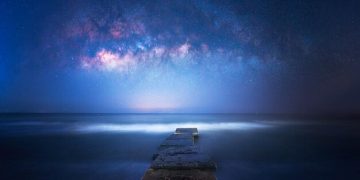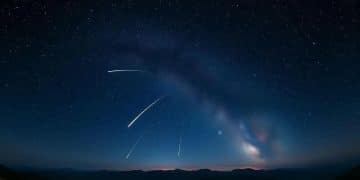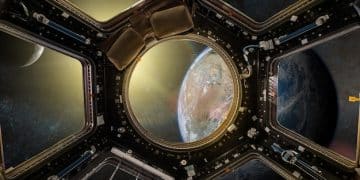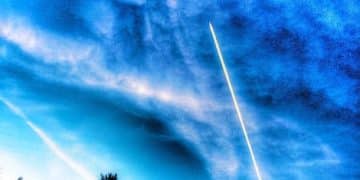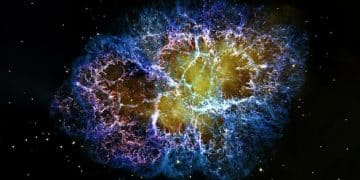Meteor Shower Guide: See the Perseids in August 2025, USA
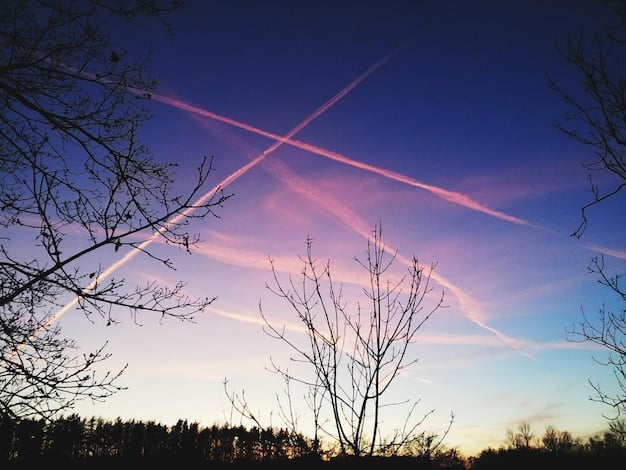
The Perseid meteor shower, a celestial spectacle, will peak in August 2025, offering prime viewing opportunities across the United States; with optimal timing and dark sky locations, observers can maximize their enjoyment of this natural light show.
Get ready for a dazzling show! The Meteor Shower Guide: Maximize Your Viewing of the Perseids in August 2025 Across the US promises an unforgettable celestial event, and with the right preparation, you can make the most of this breathtaking display.
Understanding the Perseid Meteor Shower
The Perseid meteor shower is one of the most anticipated astronomical events of the year. It’s known for its high number of meteors and bright, colorful streaks across the night sky.
But what exactly causes this annual spectacle, and why is it so special?
What are Meteor Showers?
Meteor showers occur when the Earth passes through the debris field of a comet. These debris fields are made up of small particles of dust and rock that the comet leaves behind as it orbits the sun.
As Earth moves through this field, the particles—known as meteors when they enter Earth’s atmosphere—collide with our atmosphere at high speeds, burning up and creating the streaks of light we see as meteors.
The Perseids and Comet Swift-Tuttle
The Perseid meteor shower is associated with Comet Swift-Tuttle, a large comet that orbits the sun every 133 years. The comet last passed close to the sun in 1992, and the Earth passes through its debris field every year in mid-August.
This annual encounter creates the consistent and reliable show of the Perseids, making it a favorite among stargazers.
- Peak Time: Typically peaks around August 11-13.
- Meteor Count: Can produce 50-100 meteors per hour at its peak under ideal conditions.
- Comet Origin: Originates from Comet Swift-Tuttle.
In summary, the Perseid meteor shower is a spectacular event caused by Earth’s passage through the debris field of Comet Swift-Tuttle, offering a reliable and stunning display of meteors each August.
Optimal Viewing Times for Perseids 2025
Timing is crucial when planning to view the Perseid meteor shower. Knowing when to look can significantly increase your chances of seeing more meteors.
For the Perseids in 2025, here’s what you need to know about optimal viewing times.
Peak Dates in August 2025
The Perseid meteor shower typically peaks around August 11-13. While the exact date can vary slightly each year, these dates generally provide the highest concentration of meteors.
In 2025, it’s essential to check specific astronomical calendars and forecasts to pinpoint the precise peak. These forecasts take into account factors such as moon phase and predicted meteor activity.
Best Time of Night to Watch
The best time to view the Perseid meteor shower is usually in the pre-dawn hours. After midnight, the Earth’s rotation turns observers into the direction of the meteor stream.
This means that after midnight, you are on the leading side of the Earth as it travels through space, increasing the likelihood of seeing more meteors.
- Pre-Dawn Hours: The best viewing time is typically from 2 AM until dawn.
- After Midnight: Meteor activity tends to increase significantly after midnight.
- Dark Skies: Optimal viewing requires minimal light pollution.
In conclusion, to maximize your chances of seeing the most meteors during the Perseids in 2025, plan to observe in the pre-dawn hours around August 11-13, and seek out locations with dark skies.
Top US Locations for Stargazing
Finding the right location is key to a successful meteor shower viewing experience. The ideal spot should offer dark skies, minimal light pollution, and a clear view of the horizon.
Here are some of the top locations across the United States to consider for the Perseids in 2025.
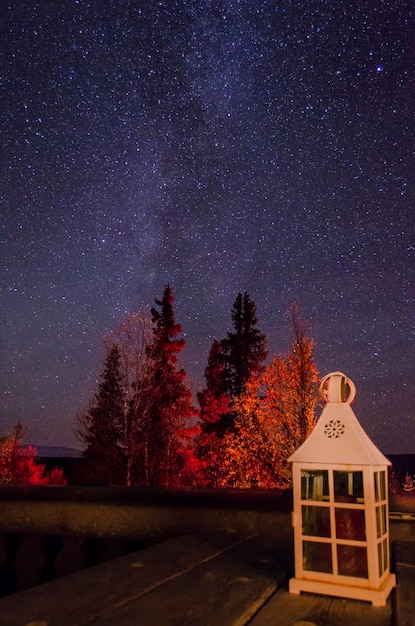
Cherry Springs State Park, Pennsylvania
Cherry Springs State Park is renowned for its exceptionally dark skies. It’s located in a remote part of Pennsylvania, far from urban light pollution, making it a prime location for stargazing.
The park often hosts astronomy events and has designated areas for setting up telescopes and viewing the night sky.
Death Valley National Park, California
Death Valley National Park offers some of the darkest skies in the United States. Its remote location and vast, open landscapes provide unobstructed views of the night sky.
The park is also known for its stunning desert scenery, making it a unique and beautiful place to observe meteor showers.
Big Bend National Park, Texas
Big Bend National Park in Texas is another excellent location for stargazing. With its remote location and minimal light pollution, it provides dark skies and clear views of the stars.
The park’s rugged mountains and desert landscapes add to the overall experience of viewing the night sky.
- Cherry Springs: Known for astronomy events and dark skies.
- Death Valley: Offers stunning desert scenery and minimal light pollution.
- Big Bend: Rugged landscapes and clear views of the stars.
- Additional Options: Acadia National Park (Maine), Bryce Canyon National Park (Utah).
Overall, these locations offer some of the best conditions for viewing the Perseid meteor shower in the United States, thanks to their dark skies and clear horizons.
Essential Equipment for Meteor Watching
While you don’t need a lot of specialized equipment to enjoy the Perseid meteor shower, having a few key items can enhance your viewing experience and keep you comfortable.
Here’s a list of essential equipment to consider bringing along.
Comfort and Convenience
Comfort is key when you’re spending several hours under the night sky. Bring a comfortable chair or blanket to sit or lie on, and dress warmly in layers, as temperatures can drop at night.
A thermos of hot chocolate or coffee can also help keep you warm and alert.
Navigation and Safety
If you’re heading to a remote location, bring a flashlight or headlamp with a red light setting. Red light preserves your night vision better than white light.
Also, bring a map or GPS device to help you navigate to your viewing spot and back safely.
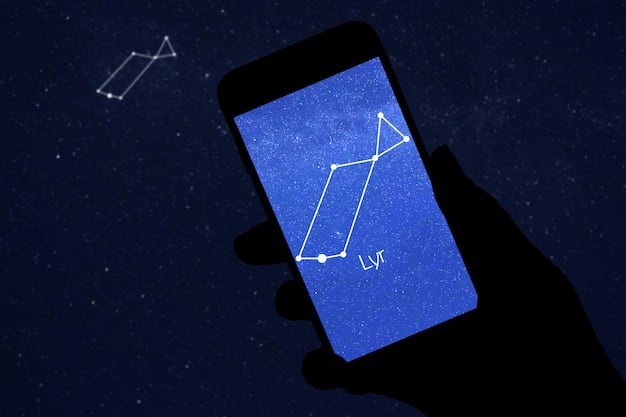
Optional Enhancements
While not essential, binoculars can enhance your viewing experience by allowing you to see fainter meteors and stars. A star chart or stargazing app on your smartphone can also help you identify constellations and other celestial objects.
Some people also like to bring a camera to try and capture images of the meteor shower, although this can be challenging without specialized equipment.
- Comfort: Chair/blanket, warm clothing, hot beverage.
- Navigation: Red flashlight, map, GPS.
- Optional: Binoculars, star chart/app, camera.
In summary, having the right equipment can significantly improve your comfort, safety, and overall enjoyment of the Perseid meteor shower.
Tips for Photographing the Perseids
Capturing the beauty of the Perseid meteor shower through photography can be a rewarding experience. However, it requires some preparation and knowledge of camera settings.
Here are some tips to help you photograph the Perseids successfully.
Camera Settings
To capture meteors, you’ll need to use a camera that allows you to manually adjust settings such as aperture, ISO, and shutter speed. A DSLR or mirrorless camera is ideal.
Use a wide aperture (e.g., f/2.8 or lower) to let in as much light as possible, and set your ISO to a high value (e.g., 1600 or 3200). Experiment with different shutter speeds, starting with around 20-30 seconds.
Equipment and Setup
A sturdy tripod is essential to keep your camera steady during long exposures. Use a wide-angle lens to capture a larger portion of the sky.
Consider using a remote shutter release or your camera’s self-timer to avoid shaking the camera when taking photos.
Location and Timing
Scout your location ahead of time to find a spot with dark skies and a clear view of the horizon. Arrive early to set up your equipment and allow your eyes to adjust to the darkness.
Monitor the weather forecast and choose a night with clear skies for the best results.
In conclusion, photographing the Perseid meteor shower requires careful planning and the right equipment, but with these tips, you can capture stunning images of this celestial event.
Understanding Light Pollution and Minimization
Light pollution is a significant obstacle to stargazing and meteor shower viewing. Understanding what it is and how to minimize its impact can greatly enhance your viewing experience.
Here’s what you need to know about light pollution and how to combat it.
What is Light Pollution?
Light pollution refers to the excessive or misdirected artificial light that obscures the night sky. It comes from various sources, including streetlights, buildings, and vehicles.
This artificial light scatters in the atmosphere, creating a glow that reduces the contrast between stars and the background sky, making it harder to see faint objects like meteors.
Minimizing Light Pollution
One of the best ways to minimize light pollution is to travel to a dark sky location away from urban areas. These locations often have regulations in place to limit outdoor lighting and preserve the darkness of the night sky.
You can also use light pollution filters on your camera or telescope to block out certain wavelengths of artificial light, improving the visibility of celestial objects.
- Dark Locations: Travel away from urban areas.
- Light Filters: Use filters to block artificial light.
- Local Efforts: Support initiatives to reduce light pollution in your community.
In short, understanding light pollution and taking steps to minimize its impact are crucial for a successful meteor shower viewing experience. Seeking out dark sky locations and using appropriate filters can significantly improve the visibility of meteors and stars.
| Key Point | Brief Description |
|---|---|
| 🌠 Peak Viewing | August 11-13 offers the best meteor activity. |
| 🌃 Dark Skies | Minimize light pollution for optimal viewing. |
| 🔭 Equipment | Bring blankets, chairs, and red light flashlights. |
| 📸 Photography | Use a tripod and wide aperture for best photos. |
What causes the Perseid meteor shower?
▼
The Perseid meteor shower is caused by Earth passing through the debris field of Comet Swift-Tuttle. As Earth moves through this field, particles enter our atmosphere and burn up, creating the streaks of light we see.
▼
The best time to view the Perseid meteor shower is typically in the pre-dawn hours around August 11-13. Meteor activity tends to increase significantly after midnight, offering the best viewing opportunities.
▼
Top locations include Cherry Springs State Park in Pennsylvania, Death Valley National Park in California, and Big Bend National Park in Texas. These areas offer dark skies with minimal light pollution.
▼
Essential equipment includes a comfortable chair or blanket, warm clothing, and a red light flashlight. Binoculars and a star chart or stargazing app can also enhance your viewing experience.
▼
To minimize light pollution, travel to a dark sky location away from urban areas. You can also use light pollution filters on your camera or telescope and support local initiatives to reduce light pollution.
Conclusion
The Perseid meteor shower in August 2025 promises to be a spectacular event for stargazers across the United States. By understanding the timing, finding dark sky locations, and preparing with the right equipment, you can maximize your chances of witnessing this breathtaking celestial display. So, mark your calendars, gather your gear, and get ready to enjoy the magic of the Perseids!
